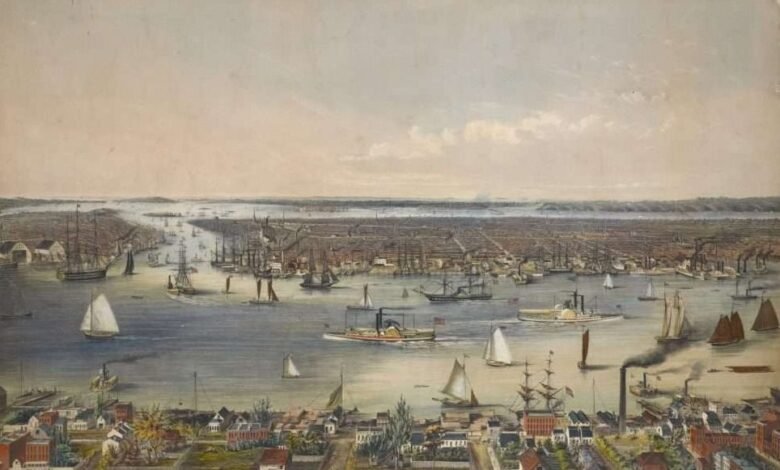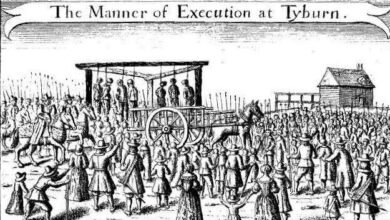Maritime History of the New York Harbor Area


 Unlike early colonial enterprises founded on political or religious principles, New York’s development was prompted by trade. Early maritime commerce in the New York Harbor area began in the early 1600s, centering around the trade and barter for furs.
Unlike early colonial enterprises founded on political or religious principles, New York’s development was prompted by trade. Early maritime commerce in the New York Harbor area began in the early 1600s, centering around the trade and barter for furs.
After the area was discovered by the Italian explorer Giovanni da Verrazzano in 1524, the Dutch began initial colonization of Manhattan Island, with the Dutch West India Company establishing a trading post of eight men in 1625 to help develop the fur trade. By 1650, New Amsterdam featured peoples speaking some 18 languages.
“This broad-minded tolerance, which was the universal Hollandish custom, attracted from Europe bold adventurers bent upon making their fortune,” one historian wrote in 1915. “In spite of the interruption of the change from Dutch to English rule, in spite of the constant warfare of the eighteenth century and the British occupation during the Revolution, New York’s commerce grew steadily. By 1800, eleven years after the adoption of the Constitution… New York had outstripped its rivals… and had taken the foremost place as the seat of American commerce.”
The fledgling colony was replaced by British rule when a naval squadron appeared in 1664 off New Amsterdam and demanded its surrender. Renamed “New York,” the colony was taken back in 1673 but was returned to the British as terms of a treaty in 1674.
In 1683 there were three ships, three barks, 23 sloops, and 41 small boats noted as being at New York. In 1696 there were 62 sloops, 40 square-rigged vessels, and 60 small boats.

 The single-masted sloop was the most extensively employed vessel type during the early years of the colony. Thought to have developed from the old Dutch yacht, the sloops had the broad beams and round, full bottoms that characterized seventeenth-century Dutch vessels.
The single-masted sloop was the most extensively employed vessel type during the early years of the colony. Thought to have developed from the old Dutch yacht, the sloops had the broad beams and round, full bottoms that characterized seventeenth-century Dutch vessels.
The universal boat for traveling and freighting on the river, the sloop’s light draught was well suited to floating over the shallows of the Hudson River. By 1771, the Hudson River Sloop was a large and powerful boat
.
The rise of New York commercial activity was slow at first, and while merchants traded to the West Indies, they neglected the trade of Europe until after the Revolutionary War.
Prior to the war, privateering and the slave trade were practiced. The port was especially known for its privateering, and from the French War and Indian War 48 privateers, 695 guns, and 5,660 men were sent out from the port until the advent of the Revolutionary War.
Fast-sailing brigs and schooners had sharp floors and sat low in the water; these vessels were seldom captured. A few of this same class of vessel also participated in the slave trade.
Part of the British strategy during the Revolution was taking control of New York Harbor, with their first landing on Staten Island. Although the major battles of the war were fought in far-flung places from the the city, the British continued to hold New York as a main naval base.
The end of the war brought restrictions against trade with the West Indies; however, the trade was revived in 1793 when France and England went to war. Becoming the leading seaport in 1797, the port was idled for over a year with the passage of the Embargo Act of 1807.

 Just four months prior to the Embargo, Robert Fulton successfully tested the steam-propelled North River Steam Boat, an event that signaled a revolution in marine transportation and waterborne commerce. Built in an East River yard and powered by an imported British steam engine, the vessel ran between New York and Albany in 1807.
Just four months prior to the Embargo, Robert Fulton successfully tested the steam-propelled North River Steam Boat, an event that signaled a revolution in marine transportation and waterborne commerce. Built in an East River yard and powered by an imported British steam engine, the vessel ran between New York and Albany in 1807.
Although earlier steamboats had operated both in the United States and abroad, it was Fulton and his partner Robert Livingston whose success with the North River Steam Boat began the unbroken development of steam navigation in the Americas.
In 1812, Fulton built the first “double-ended” ferryboat, Jersey, which operated between Jersey City and Manhattan. In 1814, he established the first steam ferry between Brooklyn and Manhattan.
The development of the steamboat was impeded by the monopoly awarded to Fulton (actually awarded to Livingston, a state political power) for steamboat operation in the state of New York.
Struck down in 1824 by the Supreme Court of the United States, the removal of the monopoly brought significant changes to the local waters, both in vessel types employing steam propulsion and the engines themselves, as well as waterborne commerce affected by the introduction of these vessel types.
A general type evolved that would come to typify the larger Hudson River steamboats, as well as those at Long Island Sound and Chesapeake Bay.
After the War of 1812, the Port of New York increased its role in the sailing packet industry, both in the construction and in the commercial aspects of the vessels. Like the North River Steam Boat, the packets were built in East River yards.
Packets bound for Liverpool, London, and Harve would make their eastbound crossing with cotton or grain and return with immigrants and European luxury goods. By 1850, New York was a center of clipper ship construction with between 50 and 100 vessels being built yearly. Mostly built for New York owners, the packets and clippers were launched for the packet, China tea, or California trades.
After the Civil War, the American shipbuilding industry saw not only the final development of the American square-rigged ship, but in New York, where builders specialized in expensive packets and clippers, a dramatic decrease in production. Production of New York-built boats dropped from 40 in 1855 to zero in 1862, averaging only four per year over the next decade.
The completion of the trans-continental railroad and the opening of the Suez Canal spelled doom for the fast sailing vessels by the 1870s. The industry also witnessed a change in the way it conducted business.
Before the Civil War, shipbuilding usually consisted of a small group of shipwrights headed by a master shipwright. Shippers, on the other hand, had little to do with shipbuilding. After the war, however, capitalists sought out the industry on a large scale.

 The master shipwright became an employee as the result of declining activity in the ship market and the increased cost of ship construction (in part due to decreased timber supply). By 1880, the economies associated with the free market system dramatically modified, if not replaced, the old apprenticeship system.
The master shipwright became an employee as the result of declining activity in the ship market and the increased cost of ship construction (in part due to decreased timber supply). By 1880, the economies associated with the free market system dramatically modified, if not replaced, the old apprenticeship system.
The opening of the Erie Canal in the fall of 1825 was perhaps the greatest stimulus to the growth and success of the Port in the early nineteenth century. Extending from Buffalo on Lake Erie to Albany on the Hudson River, the canal runs a distance of 365 miles.
Reducing shipping times and costs of inland produce and commodities to the Port, the Erie Canal caused interior towns to thrive due to increased commerce, and ensured New York’s leadership among eastern ports because of its access to markets and goods of the interior of the continent.
Soon other canals were being constructed throughout New York, with canals also constructed in Pennsylvania, Maryland, and Delaware. Navigation improvements in connecting inland waterways by canals in the 1820s and 1830s resulted in new commerce opportunities and increased maritime traffic.
The Delaware & Raritan Canal, the company by the same name receiving its charter in 1830, was the conduit for Pennsylvania coal to New Brunswick, New Jersey on the Raritan River, and the Morris Canal carried coal across New Jersey to Newark from the mouth of the Lehigh River.
A crucial corridor around Staten Island for waterborne commerce in the early nineteenth century traveling between Upper New York Bay to Raritan Bay, the importance of the Kill Van Kull and the Arthur Kill increased throughout the nineteenth century with the construction of the Delaware and Raritan Canal and the attendant expansion of the coal trade.
With later direct railroad connections from Elizabethport to Phillipsburg, New Jersey on the Delaware River, and a new coal terminal at Port Johnson, Bayonne on the Kill (constructed in 1865), shipments of coal on the kills increased dramatically in the 1850s and 1860s.

 The construction of canals brought about an attendant boom in the construction and use of canal boats or barges, as well as a reduction in the number of schooners involved in the same trade. The importance of the canal boat use in the waters of New York Harbor is indicated by the frequency with which they appear in historic photographs of the area.
The construction of canals brought about an attendant boom in the construction and use of canal boats or barges, as well as a reduction in the number of schooners involved in the same trade. The importance of the canal boat use in the waters of New York Harbor is indicated by the frequency with which they appear in historic photographs of the area.
Either decked or open, the canal barges were towed through the Erie and Champlain Canals by horses and mules walking along towpaths. Arriving at the Hudson River, they would require other means of propulsion. Coinciding with the construction of the canals and the canal barge, the advent of steam power produced the towing vessel, the predecessor of the modern-day tugboat.
The first vessel built for general towing service appears to have been the Hercules, constructed in 1832 in New York by a company that ran a line of coastal packets.
At the same time steam propulsion was making inroads into maritime construction and commerce, it was also having a profound effect on land in the form of railroads. By the 1870s, the railroads would shape the way the Port area handled goods by effectively creating the lighterage system.
Of the dozen major lines that serviced the port, only two directly serviced Manhattan Island. With the exception of the Baltimore & Ohio, which entered Staten Island, most railroads ended at the New Jersey shore of the Hudson River.
These lines were forced to transport their cargoes of passengers and products over the last remaining leg of the journey by water. However, there remained a far greater tonnage of waterborne freight requiring discharge along piers and waterfront slips than land-conveyed freight.

 Some freight cars crossed the waterways on long barges called car floats, while the contents of other cars were offloaded or transferred onto lighter barges in the form of sailing craft, deck scows, and hold and covered barges; steam lighters carried priority cargo such as mail.
Some freight cars crossed the waterways on long barges called car floats, while the contents of other cars were offloaded or transferred onto lighter barges in the form of sailing craft, deck scows, and hold and covered barges; steam lighters carried priority cargo such as mail.
Servicing the geographic and commercial needs of the harbor required a “railroad navy.” Some 1,500 tugboats, car floats, covered lighters, express lighters, floating grain elevators, and other craft loaded and unloaded freight at specially designed rail-to-water transfer piers.
This transportation network offered access to the water (slip) side of steamships, and access to parts of the harbor not accessible by rail.
Historically, New York’s leadership position in general cargo portage depended on its ability to move or “lighter” goods from ship to pier or ship to ship. The term “lighter” describes a small boat utilized as an intra-port cargo carrier.
These lighters, sail or steam propelled, handled all types of agricultural and commercial goods, including mail. The usual lighter transported between 500 and 800 tons of freight.
In New York Harbor, the term also applies to cargo ferrying via scow, barge, derrick, carfloat, or grain elevator, vis-a-vis waterfront terminals or anchored ocean vessels. The breadth of New York’s lighterage activity was part of America’s full scale entry into the industrial age and its ever increasing demand for imports of raw materials and foreign markets.
The harbor’s vast waterways and dense population initially hindered centralized railroad service. In response, many major railroads established inter-modal networks. Of the dozen or so railroad lines built during the mid-1800s, only one line, the New York Central, provided direct rail freight service to Manhattan.
From 1835 to 1865, tracks progressively penetrated the harbor, terminating at the nearest navigable waterway. Most came no closer to Manhattan than Jersey City.
In the 1870s, railroads adopted the carfloat interchange system. Cars from southern areas reached New England-bound railroads by flotation barge. In Manhattan, around 1900, and later in Brooklyn and the Bronx, float bridge stations (inland freight stations) provided mechanisms for freight marine/terrestrial interchange.
Beginning around 1860, railroads delivered (at no charge) a carload or more of incoming freight to waterfront locations within a designated harbor boundary (free lighterage limits).
Waterfront destinations received the same rate as if they were physically on the railroad line. Railroad owners had no choice but to provide free lighterage since the free service directly competed with canal boat carriers who delivered goods directly to ships or terminals, and charging for the service would drive shippers to other East Coast ports.
When later investments included port facilities, railroad owners “did not want New York to be placed at economic disadvantage in competition with East Coast ports where goods did not have to be lightered,” according to seaport historian Norman Brouwer. By the 1920s, railroads owned large lighterage fleets outright .
By 1885, New York Central Railroad maintained 92 lightering boats, and the Pennsylvania Railroad maintained 104 vessels. In 1908, the Lehigh Valley Railroad had 250 craft, while the Baltimore and Ohio had 142. Three other railroads had fleets numbering more than 200.
In 1907, the New York Central fleet moved 304,372 cars on float, or about 1,000 per day, in addition to 1,402,358 lightered tons of bulk freight, or some 5,000 tons per day (Harding 1912). In 1917, all railroad freight shipped to or from Manhattan Island (apart from New York Central’s track) arrived by lighter or carfloat.

 Expansion of the free lighterage system allowed waterfront industries to develop floating sidings. Terminal companies took advantage of the situation by developing ports within ports, providing steamship piers, loft buildings, and freight stations, all served by private rail networks connected by carfloat (train ferries).
Expansion of the free lighterage system allowed waterfront industries to develop floating sidings. Terminal companies took advantage of the situation by developing ports within ports, providing steamship piers, loft buildings, and freight stations, all served by private rail networks connected by carfloat (train ferries).
Companies set up special terminals for bananas, coal, grain, and perishables. A Merchant’s Association of New York representative described the waters of Manhattan as “an interior belt line employed in switching cars between the terminals on the New Jersey shore and the industries… in various parts of the harbor.”
The water belt line or lighterage and carfloat system came under attack around 1910. Independent cost analysis suggested that the system suffered from cost overruns, particularly delay and damage to freight.
These allegations, however, often originated from rival ports. Objections also came from urban planners, who complained about the disproportionate amount of waterfront occupied by railroad marine operations. Supporters recognized that if operations moved elsewhere in Manhattan, companies would occupy space even more valuable.
During the early part of the twentieth century, New York’s port handled 40% of all U.S. foreign trade. The average annual value of imports and exports for the port during 1911-1913 totaled $1,809,358,239, or 46.2 percent of that for the United States.
The New York Port Authority (established in 1923) tried to carry out a comprehensive plan of replacing marine operations with land-based belt lines. Railroad executives refused to cooperate with one another; despite studies showing increased revenue by unifying terminals and belt lines, rail companies preferred the traditional lighterage/carfloat system. The Port Authority modernized pier and vehicular crossings, eventually substituting motor trucks for lighterage.
Modern containerization and trucking diminished the importance of the lighterage system by 1960. The demise of the lighterage system came about with the advent of the modern standardized freight container that is adapted for quick transference from and onto train, truck and specially adapted ships.
By 1976 railroads no longer provided lighterage service. Hundreds of abandoned wooden vessels associated with this industry now litter the port’s shoreline. Steel barges contain valuable scrap and are less likely abandoned, and some derelicts served as storage units for a time, but eventually lost any useful function.
The lack of railroad initiative aided Manhattan’s port decline. Marine business slowed to the point that railroads found it cheaper to transfer freight in New Jersey by truck rather than by lighter. By the early 1970s, most free railroad lighterage in New York’s port ended. The last carfloat operation in Manhattan ended in 1976.
This essay is excerpted with minor editing for clarification from Target Investigations in Connection with the New York and New Jersey harbor Navigation Project, May 2004, prepared for the U.S. Army Corps of Engineers, New York District, by Andrew D.W. Lydecker and Stephen R. James, Jr. of Panamerican Consultants, Inc.
Illustrations, from above: New York City and New York Harbor as seen from Williamsburg, 1848, by Eliphalet M. Brown, lithograph by Edgar W. Foreman; Sloops on the Hudson at Tappan Zee by Francis Silva; The first trip of Fulton’s steamboat to Albany, 1807; Illustration of New York’s busy East River waterfront in the first half of the 19th century (provided by Village Preservation); Canal Boats on the North River, New York in Gleason’s Pictorial Drawing-Room Companion, December 25, 1852; The Maryland, a Hudson River steamboat train ferry (Catskill Public Library); and detail from “Economy: Making Dividends by Saving Them” showing the Bush Terminal Company, 1910.
Source link




